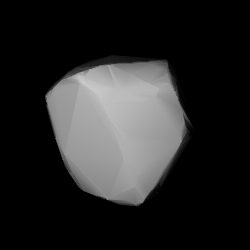Dark asteroid
2204 Lyyli (prov. designation 1943 EQ ) is a dark asteroid and very eccentric Mars-crosser from the middle region of the asteroid belt , approximately 25 kilometers (16 miles) in diameter. It was discovered on 3 March 1943 by Finnish astronomer Yrjö Väisälä at Turku Observatory in Southwest Finland.[ 3]
Orbit and classification
Lyyli orbits the Sun in the central main-belt at a distance of 1.5–3.6 AU once every 4 years and 2 months (1,522 days). Its orbit has an eccentricity of 0.41 and an inclination of 21° with respect to the ecliptic .[ 1]
Naming
This minor planet was named in honour of Lyyli Heinänen (1903–1988), née Hartonen, a Finnish female Esperantist , professor of mathematics, amateur astronomer and former assistant of the discoverer.[ 2] Minor Planet Center on 26 May 1983 (M.P.C. 7944[ 13]
Physical characteristics
Lyyli is an X-type asteroid in the SMASS classification .[ 1] P-type asteroid by NASA's NEOWISE mission.[ 11]
It has a rotation period of 11 hours[ 9] albedo between 0.02 and 0.05, according to the surveys carried out by IRAS , Akari , and WISE /NEOWISE.[ 4] [ 6] [ 11] 132 Aethra and 323 Brucia , with diameters of 43 and 36 kilometers, respectively.
References
^ a b c d e f g "JPL Small-Body Database Browser: 2204 Lyyli (1943 EQ)" (2016-12-01 last obs.). Jet Propulsion Laboratory . Retrieved 12 June 2017 .^ a b Schmadel, Lutz D. (2007). "(2204) Lyyli". Dictionary of Minor Planet Names Springer Berlin Heidelberg . p. 179 . doi :10.1007/978-3-540-29925-7_2205 . ISBN 978-3-540-00238-3 ^ a b "2204 Lyyli (1943 EQ)" . Minor Planet Center . Retrieved 7 December 2016 .^ a b c d Tedesco, E. F.; Noah, P. V.; Noah, M.; Price, S. D. (October 2004). "IRAS Minor Planet Survey V6.0" . NASA Planetary Data System : IRAS-A-FPA-3-RDR-IMPS-V6.0. Bibcode :2004PDSS...12.....T . Retrieved 22 October 2019 . ^ a b c d "LCDB Data for (2204) Lyyli" . Asteroid Lightcurve Database (LCDB). Retrieved 7 December 2016 .^ a b c d Usui, Fumihiko; Kuroda, Daisuke; Müller, Thomas G.; Hasegawa, Sunao; Ishiguro, Masateru; Ootsubo, Takafumi; et al. (October 2011). "Asteroid Catalog Using Akari: AKARI/IRC Mid-Infrared Asteroid Survey" . Publications of the Astronomical Society of Japan . 63 (5): 1117– 1138. Bibcode :2011PASJ...63.1117U . doi :10.1093/pasj/63.5.1117 online , AcuA catalog p. 153 )^ Gil-Hutton, R.; Cañ; ada, M. (April 2003). "Photometry of Fourteen Main Belt Asteroids" . Revista Mexicana de Astronomía y Astrofísica . 39 : 69– 76. Bibcode :2003RMxAA..39...69G . Retrieved 7 December 2016 . ^ Mohamed, R. A.; Krugly, Yu. N.; Velichko, F. P. (April 1994). "Photometry of two Mars-crossing asteroids 2078 Nanking and 2204 Lyyli" . Planetary and Space Science . 42 (4): 341– 343. Bibcode :1994P&SS...42..341M . doi :10.1016/0032-0633(94)90107-4 . Retrieved 7 December 2016 . ^ a b Warner, Brian D. (October 2010). "Asteroid Lightcurve Analysis at the Palmer Divide Observatory: 2010 March - June" (PDF) . Minor Planet Bulletin . 37 (4): 161– 165. Bibcode :2010MPBu...37..161W . ISSN 1052-8091 . Retrieved 18 March 2020 . ^ Warner, Brian D. (January 2016). "Asteroid Lightcurve Analysis at CS3-Palmer Divide Station: 2015 June-September" (PDF) . Minor Planet Bulletin . 43 (1): 57– 65. Bibcode :2016MPBu...43...57W . ISSN 1052-8091 . Archived from the original (PDF) on 3 October 2020. Retrieved 18 March 2020 . ^ a b c d Mainzer, A.; Grav, T.; Masiero, J.; Hand, E.; Bauer, J.; Tholen, D.; et al. (November 2011). "NEOWISE Studies of Spectrophotometrically Classified Asteroids: Preliminary Results" . The Astrophysical Journal . 741 (2): 25. arXiv :1109.6407 Bibcode :2011ApJ...741...90M . doi :10.1088/0004-637X/741/2/90 . Retrieved 2 May 2016 . ^ Veres, Peter; Jedicke, Robert; Fitzsimmons, Alan; Denneau, Larry; Granvik, Mikael; Bolin, Bryce; et al. (November 2015). "Absolute magnitudes and slope parameters for 250,000 asteroids observed by Pan-STARRS PS1 - Preliminary results" . Icarus . 261 : 34– 47. arXiv :1506.00762 Bibcode :2015Icar..261...34V . doi :10.1016/j.icarus.2015.08.007 . Retrieved 7 December 2016 . ^ "MPC/MPO/MPS Archive" . Minor Planet Center . Retrieved 7 December 2016 .
External links
